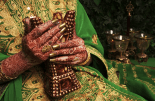
If you are planning a wedding, you might be interested to find out more about these interesting wedding facts from all over the world.
The United States
 · Although there is no law in America which states that a bride has to take her husband’s surname, around 70% of American brides decide to change their name after the ceremony
· Although there is no law in America which states that a bride has to take her husband’s surname, around 70% of American brides decide to change their name after the ceremony
· Las Vegas holds the title of being the most popular wedding destination, with more than 100,000 ceremonies being performed there over the course of a year. Hawaii comes in second, where 25,000 weddings are held
· The average number of guests at an American wedding ceremony is 175
· The most popular month to get married in the USA is June, with the second most popular being August
· Around $72 billion every year is spent on weddings in the USA
· In America, the most popular day to get married is a Saturday. Usually it costs more to get married in the early evening or late afternoon than to get married in the morning.
European Traditions
 · At one time in the UK, a bride was supposed to kiss a chimney sweep on the day of her wedding to ensure good luck. Chimney sweeps were believed to have special powers as they swept away evil spirits when they cleaned chimneys
· At one time in the UK, a bride was supposed to kiss a chimney sweep on the day of her wedding to ensure good luck. Chimney sweeps were believed to have special powers as they swept away evil spirits when they cleaned chimneys
· There was a custom in Ireland to tie a hen that was about to lay an egg to the marital bed in order to guarantee the couple’s fertility
· In Greece, there was a belief that putting a lump of sugar in the wedding gown would ensure a sweet married life
· Traditionally, green is never worn at a Scottish wedding as it is believed to be an omen of revenge and also the colour of the fairies. It is even believed to be unlucky to eat a green vegetable at a wedding reception
· In some Mediterranean countries, wedding guests are given almonds representing both the sweet and bitter sides of married life
· In some European countries including Greece and Germany, the bride tries to cover the foot of her new husband while they dance so she can establish her dominance in the relationship
Weddings Through History
 · In early Roman times, a bride would carry a bunch of herbs under her veil as a symbol of fertility and fidelity as well as to ward off evil spirits. This is now seen as the precursor of today’s bridal bouquet
· In early Roman times, a bride would carry a bunch of herbs under her veil as a symbol of fertility and fidelity as well as to ward off evil spirits. This is now seen as the precursor of today’s bridal bouquet
· The wedding ring is generally worn on the left hand’s third finger because there was a belief in ancient times that the vein in this finger ran directly to the heart
· Traditionally, the early Greeks and Romans threw seed-bearing plants, dates and nuts over the wedding couple
· Weddings guests during ancient times had a tradition of tearing off a part of the bride’s dress as a good luck token. Today, this is manifested in the bride’s throwing of the bouquet and garter
· We often use the phrase “tying the knot” without knowing that it originates from a Babylonian custom in which a knot was tied in threads from the bride and bridegroom’s clothing as a symbol of their union. Even today, ceremonial knots are often made at wedding ceremonies in some cultures
· Traditionally, a wedding cake symbolises fertility and luck. Even the ancient Romans had their own wedding cake in the form a small bun which was broken over the bride’s head at the end of the wedding ceremony. In the Medieval period, brides and grooms kissed over small cakes
· Puritans forbade the wearing of a wedding ring as they believed them to be frivolous or a relic of Popery
· In Medieval Europe, the lord of the manor had an entitlement called the “right of the lord” which legally allowed him to spend the wedding night with any non-noble bride who lived on his land
· In Old English, the word bridelope was used for a wedding ceremony, translated literally as “bridal run”.
· When Queen Victoria married Albert her wedding cake measured three yards in width and it weighed in at 300 lbs
Weddings in Asian Cultures
 · In many Eastern cultures white represents the colour of mourning and therefore it is not common to wear a white wedding dress
· In many Eastern cultures white represents the colour of mourning and therefore it is not common to wear a white wedding dress
· There is a belief in Fiji that Nangganangga, the god who watches over married couples will never allow bachelors to enter paradise, turning them into ash if they die before they marry
· In Thailand, grooms often discover that the entrance to their bride-to-be’s home is barred until he gives her family money in order to gain access. Some Central Asian nomadic tribes have a tradition of the groom pursuing his bride on a horse as she rides away carrying a freshly slaughtered lamb
· In Korea, a groom may request for a friend who is happily married to make two wooden ducks to keep in his marital home as ducks are thought to mate for life
· Frequently, an oriental wedding dress will feature embroidered cranes as they are a symbol of enduring fidelity. A a Japanese wedding, having 1001 origami cranes made from white paper is believed to be lucky
· In Tibet, it is common for women to have multiple husbands. Often a herdsman shares his wife with his half-brothers and brothers
· In Indian culture, if you are symbolically married to a tree you are considered to be protected and blessed with good luck
Marriage Traditions in Africa
 · A Bedouin girl often starts sewing her wedding dress at the age of 9, allowing her to complete it before she marries when she reaches the age of 14 or 15
· A Bedouin girl often starts sewing her wedding dress at the age of 9, allowing her to complete it before she marries when she reaches the age of 14 or 15
· Women in Egypt often pinch the bride as this is thought to bring them good luck
· In certain tribes in Ethiopia, women put plates into their lower lip so that they can attract a rich husband. The bigger the lip, the more a groom is prepared to pay
